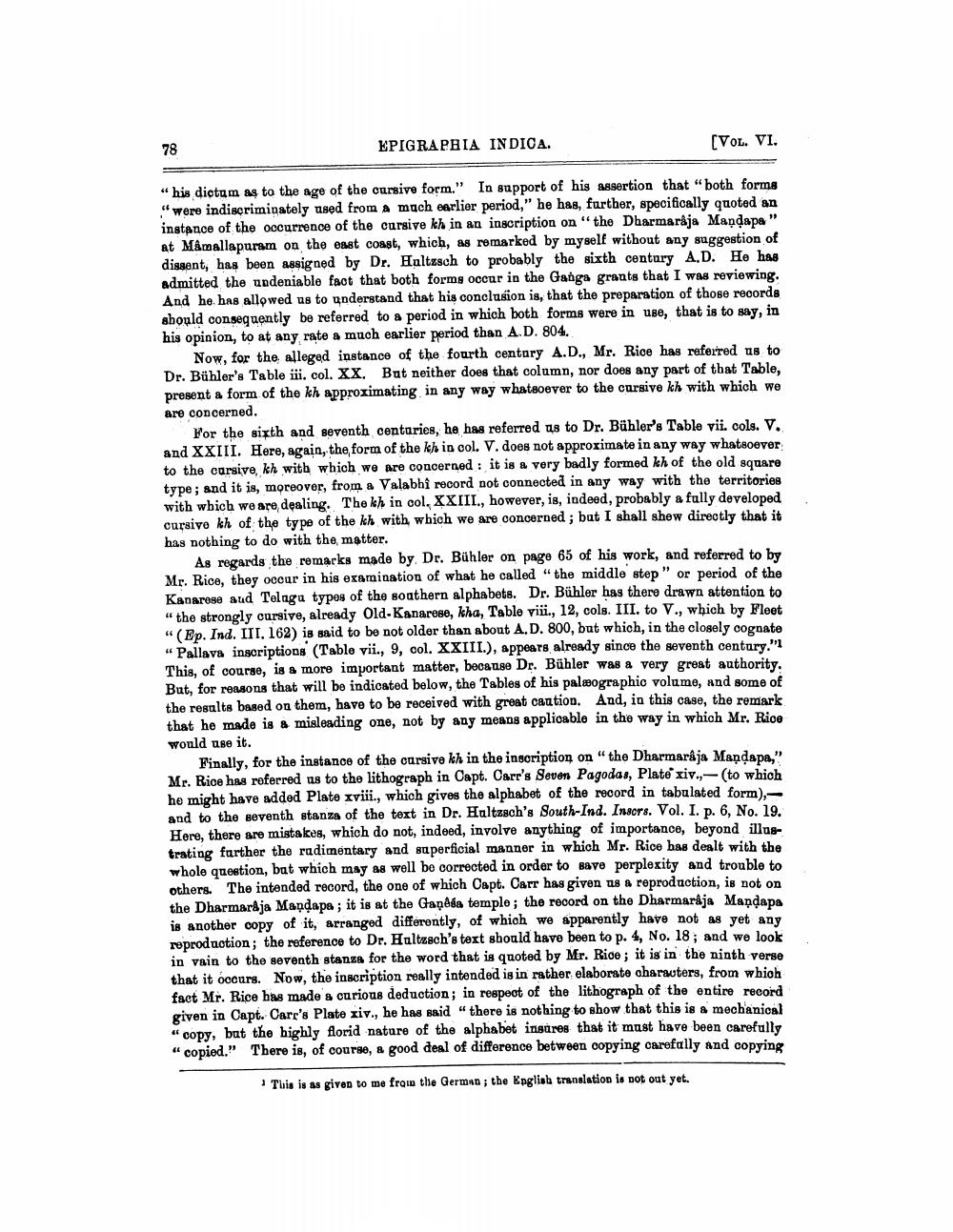________________
78
EPIGRAPHIA INDICA.
[VOL. VI.
66
"his dictum as to the age of the cursive form." In support of his assertion that "both forms were indiscriminately used from a much earlier period," he has, further, specifically quoted an instance of the occurrence of the cursive kh in an inscription on "the Dharmaraja Manḍapa " at Mamallapuram on the east coast, which, as remarked by myself without any suggestion of dissent, has been assigned by Dr. Haltzsch to probably the sixth century A.D. He has admitted the undeniable fact that both forms occur in the Ganga grants that I was reviewing. And he has allowed us to understand that his conclusion is, that the preparation of those records should consequently be referred to a period in which both forms were in use, that is to say, in his opinion, to at any rate a much earlier period than A.D. 804.
Now, for the alleged instance of the fourth century A.D., Mr. Rice has referred us to Dr. Bühler's Table iii. col. XX. But neither does that column, nor does any part of that Table, present a form of the kh approximating in any way whatsoever to the cursive kh with which we are concerned.
For the sixth and seventh centuries, he has referred us to Dr. Bühler's Table vii. cols. V. and XXIII. Here, again, the form of the kh in col. V. does not approximate in any way whatsoever to the cursive, kh with which we are concerned: it is a very badly formed kh of the old square type; and it is, moreover, from a Valabhi record not connected in any way with the territories with which we are dealing. The kh in col, XXIII., however, is, indeed, probably a fully developed cursive kh of the type of the kh with which we are concerned; but I shall shew directly that it has nothing to do with the matter.
As regards the remarks made by Dr. Bühler on page 65 of his work, and referred to by Mr. Rice, they occur in his examination of what he called "the middle step" or period of the Kanarese and Telugu types of the southern alphabets. Dr. Bühler has there drawn attention to "the strongly cursive, already Old-Kanarese, kha, Table viii., 12, cols. III. to V., which by Fleet "(Ep. Ind. III. 162) is said to be not older than about A. D. 800, but which, in the closely cognate "Pallava inscriptions (Table vii., 9, col. XXIII.), appears already since the seventh century."l This, of course, is a more important matter, because Dr. Bühler was a very great authority. But, for reasons that will be indicated below, the Tables of his paleographic volume, and some of the results based on them, have to be received with great caution. And, in this case, the remark that he made is a misleading one, not by any means applicable in the way in which Mr. Rice would use it.
Finally, for the instance of the cursive kh in the inscription on "the Dharmaraja Mandapa," Mr. Rice has referred us to the lithograph in Capt. Carr's Seven Pagodas, Plate" xiv.,- (to which he might have added Plate xviii., which gives the alphabet of the record in tabulated form),and to the seventh stanza of the text in Dr. Hultzsch's South-Ind. Insors. Vol. I. p. 6, No. 19. Here, there are mistakes, which do not, indeed, involve anything of importance, beyond illustrating further the rudimentary and superficial manner in which Mr. Rice has dealt with the whole question, but which may as well be corrected in order to save perplexity and trouble to others. The intended record, the one of which Capt. Carr has given us a reproduction, is not on the Dharmaraja Mandapa; it is at the Gapêéa temple; the record on the Dharmaraja Mandapa is another copy of it, arranged differently, of which we apparently have not as yet any reproduction; the reference to Dr. Hultzsch's text should have been to p. 4, No. 18; and we look in vain to the seventh stanza for the word that is quoted by Mr. Rice; it is in the ninth verse that it occurs. Now, the inscription really intended is in rather elaborate characters, from which fact Mr. Rice has made a curious deduction; in respect of the lithograph of the entire record given in Capt. Carr's Plate xiv., he has said "there is nothing to show that this is a mechanical copy, but the highly florid nature of the alphabet insures that it must have been carefully "copied." There is, of course, a good deal of difference between copying carefully and copying
This is as given to me from the German; the English translation is not out yet.




